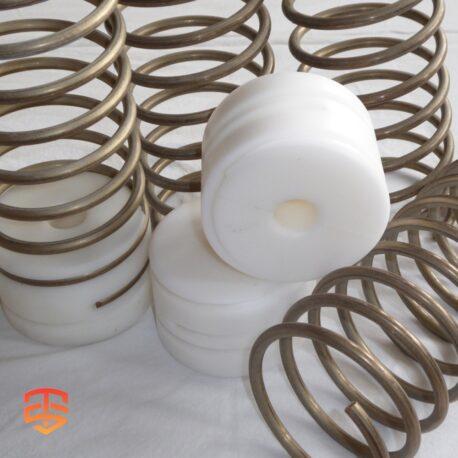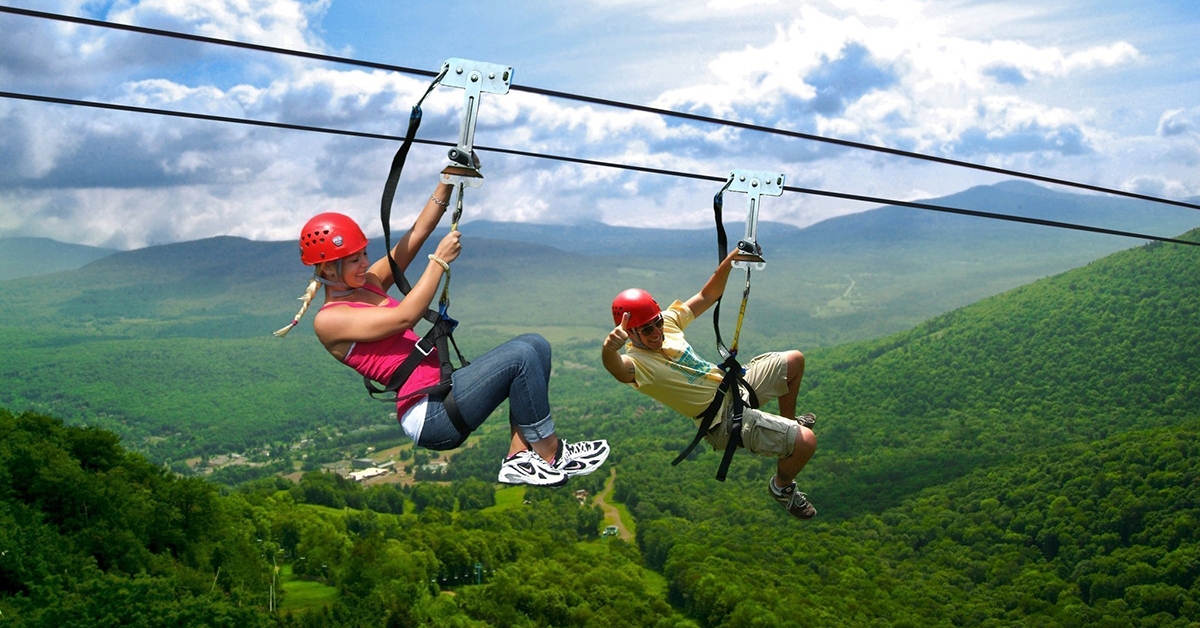
Zip line brakes are divided into two types: active and passive. The sort of brake you select will have a significant impact on your company’s risk management and the longevity of your zip line materials. The rider must initiate the braking procedure with active zip line brakes. The rider or a guide does not have to do anything to activate the passive zip line brakes. While active brakes allow riders to be more involved in the experience, they also add a layer of risk.
Active Braking
Leather gloves and brake pads are the most typical active zip line brakes. To slow down, participants must purposefully press a glove or brake pad against a zip line cable. For a variety of reasons, active brakes significantly increase the danger of damage to players. It’s easy for participants to get caught up in the thrill of the moment and forget about the braking instructions. Furthermore, active brakes force the rider’s hands and limbs to be near to fast-moving zip line components. Proximity alone increases the chance of a participant receiving a friction burn on an exposed area of skin or having their hand mangled by the passenger trolley. When it comes to active brakes, these are among the least serious injuries that can occur. The most serious injuries that can result from active brakes are life-threatening.
Riders who are inexperienced or overwhelmed are at the greatest risk of life-threatening injuries when zip line operators use aggressive braking tactics. Because they are not prepared for the great heights and speeds of zip lining, some participants may become overwhelmed. In the worst-case scenario, riders will pass out from exhaustion. It goes without saying that unconscious participants are incapable of breaking themselves.
Even if the participant does not pass out, there is still a risk to the riders. If a cyclist loses their concentration or becomes preoccupied, they may brake too late or not at all. There are many persons who are prone to losing their cool or being sidetracked. This user group is dominated by young individuals and youngsters, however it can affect persons of any age. Active braking has a number of drawbacks, including an increased chance of injury.
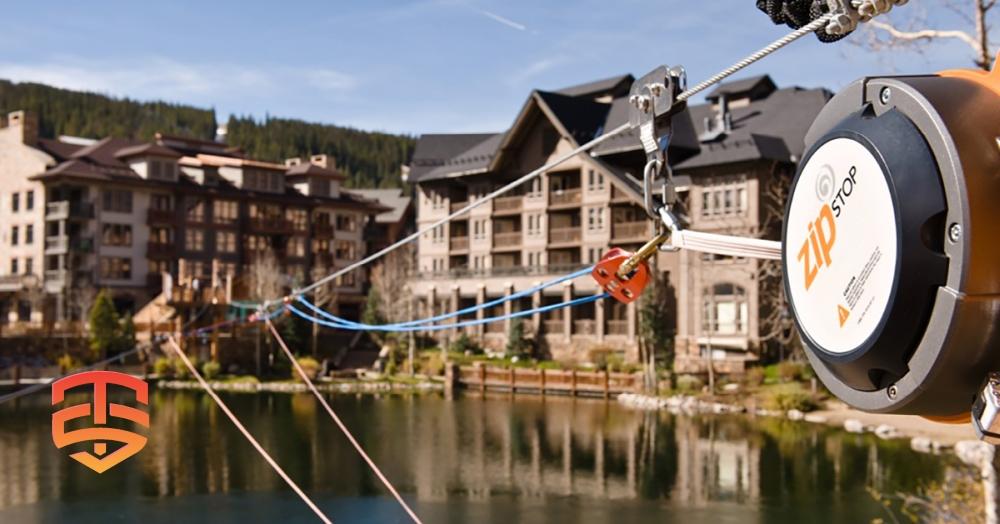
What happens if the motorcyclists decide to brake too soon or too hard? The solution is that they miss the platform and the rest of the group must wait for them to make it to the end of the line. Your zip line operation’s efficiency will suffer as a result of premature braking. The more satisfied people you can attract with your zip line course, the more money you can make. Even 30 seconds of downtime per customer can significantly diminish your zip line facility’s efficiency. Active braking does not provide you a great deal of control over the speed of your zip line. You should read this article on Head Rush Technologies’ solution to the problem if you want to improve the efficiency of your zip line operation.
One last reservation about active brakes. They put more strain on the zip line’s critical components. Friction is required by active brakes, and there is no way to avoid it. Friction is the key component that allows active brakes to function. This friction is what causes your zip line cable and active brake to wear out more quickly. Due to increased wear, you’ll need to replace your zip line cable more frequently, in addition to replacing your gloves and brake pads on a regular basis. It also means you’ll be without power for longer while your cable and other components are replaced. Active braking may appear to be less expensive at first, but it will wind up costing you more in the long term.
Increased injury risk, lower throughput, and higher material replacement costs are among the additional costs of active braking. Your decision to adopt active braking tactics could make or break your business. The biggest worry is the possibility of harm. If a customer is injured on your course, you may be required to pay a large sum of money as a legal remedy. Even if there is no financial loss as a result of an injury or death, your company’s reputation may be jeopardized.
Your company’s safety reputation is critical. Potential clients can simply research a company’s history using the internet in this day and age. A bad safety reputation might mean the difference between having the best zip line in town and declaring bankruptcy. Don’t put your company’s future at jeopardy.
Spring Brake System | Primary & EAD zipline brake
The professional Zipline Spring Brake is a reliable primary and secondary zipline braking component designed for high speeds and big impacts. It’s durable, efficient, and requires minimal maintenance.
Passive Braking
There are many different types of passive braking. The most commonly used passive brakes are: magnetic brakes, gravity brakes, and spring brakes. Passive brakes take the responsibility of braking away from the rider. Passive braking methods will activate even if the participant suffers a breakdown mid zip and is unable to stop themselves. This aspect of risk management alone makes passive brakes superior to active brakes. There are many zip line brakes that fall into the passive brake category. How do different passive zip line brakes compare?
Magnetic Brakes
The zipSTOP Zip Line Brake is the only passive zip line brake in its class. The zipSTOP is the world’s only magnetic zip line brake. The zipSTOP eliminates the requirement for sacrificial brake components by employing eddy current magnetic braking technology. That means there are no friction-based brake pads or internal braking components at all. As a result, the zipSTOP requires less maintenance because the braking core contains no components that are designed to wear out or fail. The magnetic technology does more than only reduce maintenance and extend the life of the product.
By self-regulating braking resistance for each individual, the zipSTOP’s eddy current magnetic braking technology provides users with consistently smooth braking experiences. The same comfortable deceleration will be felt by a 33-pound child and a 330-pound football player. Other zip line brakes lack the ability to self-regulate their braking resistance. Without the zipSTOP’s automatic braking resistance regulation, the 33-pound kid will experience a stronger jolt on contact than heavier riders. Magnetic braking enables zip line operators to offer every participant with the same high-quality zip line experience, regardless of weight. If you want to read more about the science behind eddy current magnetic braking, click here.
The zipSTOP is fantastic for increasing throughput in addition to the benefits of magnetic braking. After each use, the zipSTOP automatically resets. It takes less time for the guide to reset the brake for the following rider when the brake is automatically reset. Automatic brake reset also reduces the possibility that the guide will forget to do so. When paired with additional Head Rush zip line attachments, the zipSTOP’s throughput efficiency is increased. The zipSTOP zip line brake system’s brake trolley can be equipped with a catch mechanism that works in tandem with the Head Rush Impact Trolley to prevent rider rollover. During the braking procedure, the Impact Trolley and the Brake Trolley clasp together, making rider retrieval quick and painless. Because there is less downtime between riders, you can get more clients through your course each day, increasing your total potential revenue. If you want to increase the flow of your zip line, use this one simple approach to double its efficiency.
The zipSTOP is a totally unique zip line brake because of its low maintenance, smooth braking feel, and higher throughput. There is currently no zip line brake that compares to the zipSTOP as of the writing of this article. You won’t be able to get a zip line brake with the same features and benefits anyplace else. The zipSTOP is the most popular zip line brake among zip line operators.
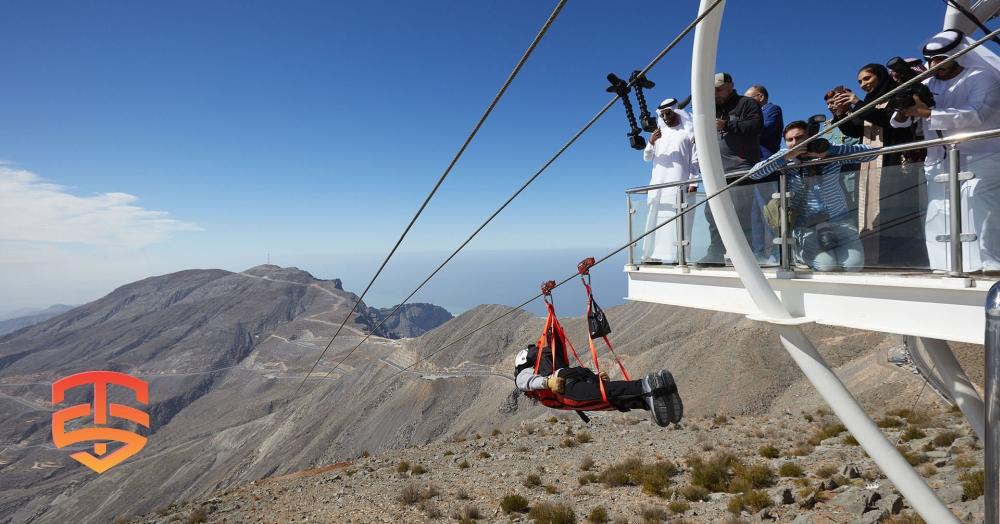
Self Braking Magnetic Zipline Trolleys
The MAG Brake Trolley, a magnetic self braking Zipline trolley is equipped with a powerful and incrementally adjustable and Integrated Magnetic Brake. Zipline is composed from the trolley that is attached to the inclined safety line. Therefore, the user can travel down the zipline due to the force of gravity. The predecessor forms of today’s ziplines have been used for centuries. In remote areas many cableways were used for transportation of wood and hay over deep canyons. In the jungle cableways have been used by research expeditions for the transportation of things and materials as the transportation above treetops was much faster and more convenient than the transportation by foot through the dense jungle vegetation.
Nowadays, ziplines are employed for recreational and tourist purposes in adrenaline parks. Clients want to develop ever longer and steeper ziplines to stand out with the adrenaline activities they offer because to the fierce competition on the market.
When the zipline’s gradient is greater than 8%, one of two types of trolleys can be used: the end-braked trolley or the self-braking trolley. This allows for a safe journey down the zipline while also reducing the speed at the conclusion. The market for self-braking trolleys that can be used for steep zipline descents is extremely limited.
Eddy currents are created in the non-ferromagnetic material of the trolley’s outer case during magnetic braking of the self-braking magnetic trolley that is used for descent down the zipline. These eddy currents produce a magnetic field that resists the change in the primary magnetic field of the trolley’s magnets, resulting in the release of heat as a by-product. This heat shortens the life of the trolley’s components and diminishes their breaking capability.
Our self-cooling magnetic trolley, on the other hand, solves this significant issue by incorporating wings into both of the trolley’s wheels. The magnets and the trolley’s exterior case (where the initial eddy currents are created) are kept cool by these wings. Our trolleys are one of the smallest on the market thanks to this unique cooling technology. They ensure that the magnets are braking as efficiently as possible.
Another feature that distinguishes our trolleys is the steel safety carabiner that is fastened to the trolley’s safety line and impact surface (via magnets that are inbuilt into this impact surface).
-
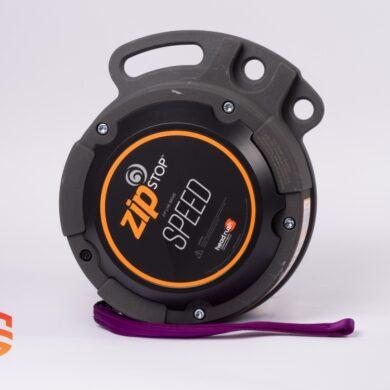 zipSTOP SPEED Zipline Brake | 50 – 72 kph€ 6.099,00 – € 6.349,00 Ex VAT
zipSTOP SPEED Zipline Brake | 50 – 72 kph€ 6.099,00 – € 6.349,00 Ex VAT -
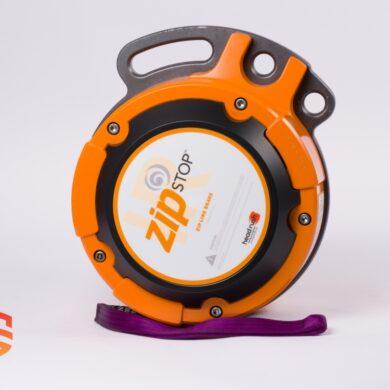 zipSTOP IR Zipline Brake | 24 – 60 kph€ 5.649,00 – € 5.799,00 Ex VAT
zipSTOP IR Zipline Brake | 24 – 60 kph€ 5.649,00 – € 5.799,00 Ex VAT -
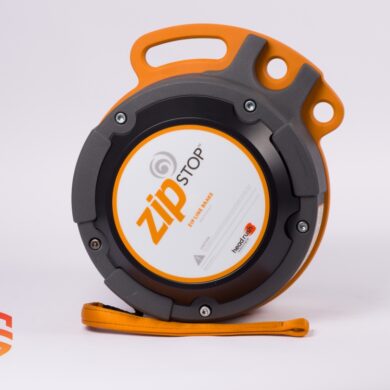 zipSTOP Zipline Brake | 0 – 36 kph€ 5.249,00 – € 5.499,00 Ex VAT
zipSTOP Zipline Brake | 0 – 36 kph€ 5.249,00 – € 5.499,00 Ex VAT
The Self-braking magnetic zipline trolley:
1. Eliminates the risk of human error.
The manual adjustment step is removed.
2. Makes braking smooth.
The participants are braked by the gradual, speed-dependent widening of the discs. When the speed increases, the discs move closer to the magnets, braking the descent; when it decreases, they return to their initial position.
3. Increase logistic efficiency.
You can save time and money, by purchasing a single effective solution for both children and adults. The phase of choosing the most suitable device is eliminated.
Gravity Brakes
The absence of a zip line brake is what a gravity brake is. Gravity brakes are zip lines that are designed to prevent the rider from reaching the finish. Zip lines with gravity brakes usually have a substantial amount of slack, so the cable ends upwards. The rider is slowed by the uphill segment of the zip line until they change directions. Then they boomerang back and forth until they finally come to a halt at the line’s sagging low point.
In order for gravity brakes to work, most zip lines must employ a shallow slope. As a result, gravity brake zip lines tend to be slower. When using a gravity brake, high-tension, high-velocity zip lines are not an option. For the same reason, gravity brakes are less popular on longer zip lines. The longer your zip line is, the more time participants have to get up speed. The more cable you have to commit to the uphill portion of the line, the faster your cyclist is going. If your zip line course is designed to provide long-distance or high-speed experiences, a gravity brake should be considered.
Gravity brakes have another disadvantage: they have a poor throughput. A participant must ricochet back and forth for long enough to come to a halt. The section of the zip line where you have to roll back and forth to slow down is the least enticing. The bit about slowing down is the most tedious. Especially when the motion is extended into a sluggish swinging motion. The time spent waiting for a gravity brake to slow a participant adds no value to the customer’s experience. This time would be better spent dispatching another rider down the line, allowing the entire group to spend less time waiting and more time zipping.
The poor use of space is arguably the most irritating drawback of gravity brakes for zip line operators. The majority of zip line operators want to incorporate as much of their terrain as possible into their course. Gravity brakes necessitate dedicating a piece of the cable to braking, which implies that a portion of the cable, as well as a portion of your facility, is virtually unusable. Consider how much scenery and enjoyment your clients are missing out on since the last portion of your cable is purposefully designed to never be used.
All of these flaws exist before you even try to get people to stop at a platform that isn’t at the bottom of the line. When you ask players to time a landing on a platform, you introduce a new set of issues. Every cyclist is unique, making it difficult to estimate where the riders will finish. Lightweight riders will typically come to a halt just short of the platform. Heavier riders will approach the platform too quickly, putting themselves and the zip line workers at risk of injury. Depending on the situation, you may wind up jeopardizing your productivity or perhaps facing a lawsuit.
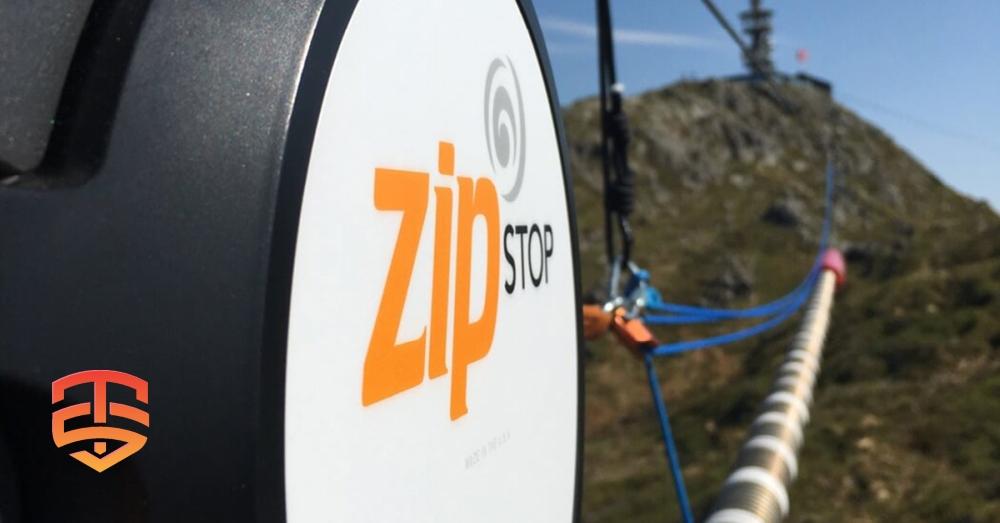
Spring Brakes
Spring brakes are massive metal coils that compress when they come into contact with something. The spring’s compression absorbs the rider’s velocity and brings them to a halt. Spring brakes decompress and propel the rider back out in the same direction they came from. Obviously, this is a problem for zip line throughput. The time it takes for cyclists to cease bouncing is valuable time. Every second a consumer spends bouncing about at the end of the line is time you could be getting another customer through the course. These seemingly minor inefficiencies build up quickly and have a big influence on throughput. Customer happiness and the efficiency of your organization are both dependent on throughput.
Before you start braking, a number of factors combine to determine your final speed at the conclusion of the zip line. Weight of the rider, wind speed, and cable conditions are just a few of the variables to consider. Spring brakes are a one-size-fits-all solution that isn’t always the best. With spring brakes, different weight cyclists will have varying braking experiences. Heavier riders will produce more spring compression, resulting in a faster rebound. Lightweight cyclists will compress the spring less than heavy riders, resulting in a more abrupt stop. Even before any other circumstances are taken into account, there is a large variety of probable outcomes.
The range of possible landing speeds is further widened by weather conditions and other factors. Riders will be slowed by headwinds and sped up by tailwinds. Riders will come sooner if the cable is wet from rain or morning dew than if the line is dry. Spring brakes on zip lines cannot and will not alter braking resistance for all of these instances. You won’t be able to deliver a consistent smooth braking experience if you can’t change the braking resistance. Some of your riders will most likely brake smoothly, but the bulk will endure a harsh stop. Don’t you want to make sure your passengers don’t get a nasty jolt at the end of your zip line?
Spring brakes aren’t ideal as primary brakes for zip lines for the reasons stated above. Spring brakes, on the other hand, are excellent as emergency stoppers. All zip lines with speeds greater than 6 mph must have an emergency arrest system, according to ACCT guidelines (10 kph). Emergency arrest devices are backup zip line brakes that operate independently of the primary brake and do not require the participant to take any effort to activate. Emergency arrest devices, in other words, are passive brakes that operate independently of the primary brake. As a result of operator error or equipment failure, emergency arrest mechanisms are designed to avoid significant harm or death. The purpose of emergency arrest devices is not to be pleasant or to have a high throughput. As a result, spring brakes should be considered as a backup option.
Conclusion
Zip line brakes that are passive are superior to active zip line brakes. The fundamental advantage of passive zip line brakes is that they reduce the possibility of players injuring themselves by braking incorrectly. The zipSTOP distinguishes out among passive zip line brakes as the best in the business. Because of its ability to give a comfortable braking experience, automatically reset, boost throughput, and modulate brake resistance, the zipSTOP is excellent. When used as an emergency arrest device, spring brakes are a perfect complement to the zipSTOP, but when used as a primary brake, they fall short. The zipSTOP is a zip line brake that has everything you need.
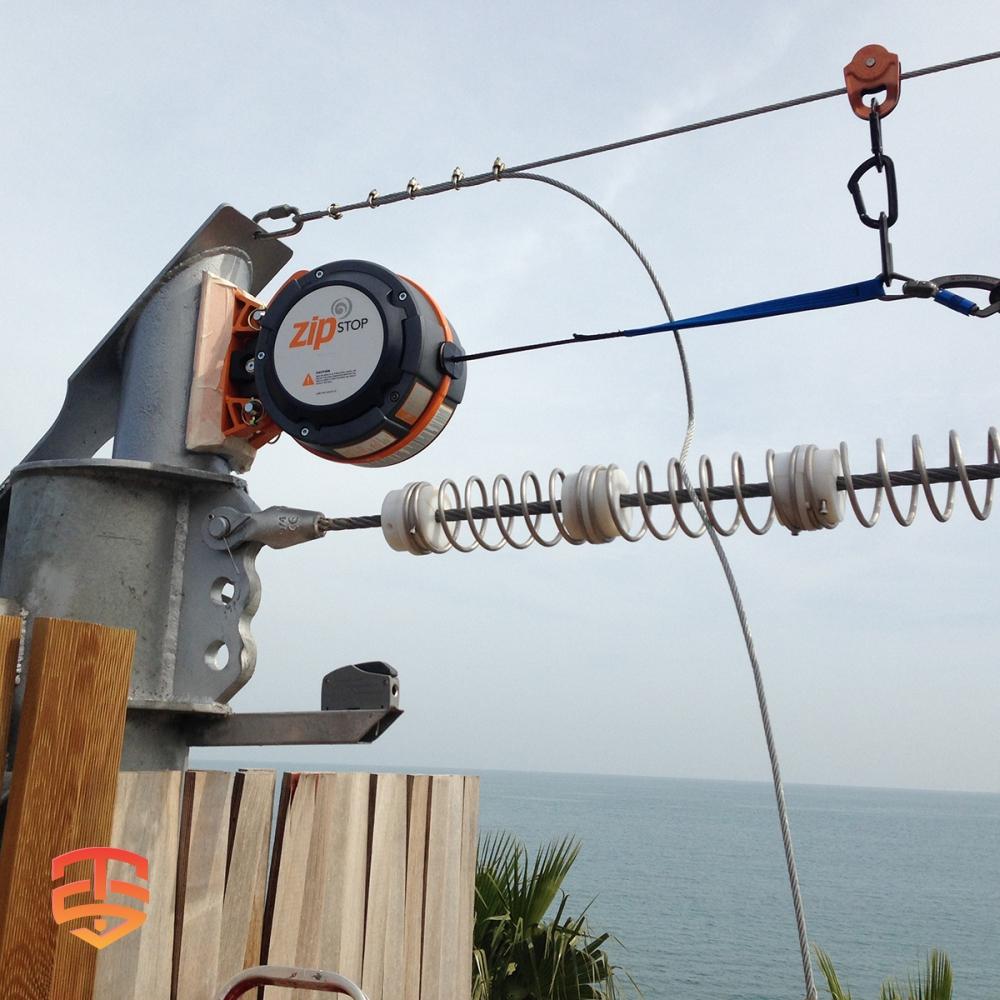
Zipline Safety Solutions
We deliver a complete professional Zipline system, from our Self-braking Magnetic Zipline Trolley to a safe Zipline Spring Brake.
We offer a full family of zip line brakes that increase throughput with a hands-free braking experience for zip line riders and operators, and a full ecosystem of zip line products to outfit the best zip line builds in the world. We use advanced technology to engineer and manufacture innovative adventure equipment for the outdoor, amusement and recreation industries.
Beyond the Basics: Unveiling Zipline Technology with Expert Analysis
Intrigued by the potential of Zipline technology? You’ve come to the right place! This article provides a solid foundation. But if you’re eager to delve deeper and gain insights from industry experts, keep reading…
- Zip Line Design: Components for a Complete System
- Considering operating and investing in a zipline?
- 9 Zipline Mistakes You Don’t Know You’re Making
- Magnetic Zipline Braking: A Revolutionary Way to Ensure Safe Rides
- Pros and Cons of Different Zip Line Brakes
- Expert Tips for Zip Line Brake Installations
- White Paper on Zipline Emergency Arrest Devices (EAD)
- The Importance of Optimizing Zip Line Design for Rider Speed
- Does your zip line need an emergency arrest device?
- The Magnetic Self-braking Zipline pulley
- Zipline Braking and landing considerations
- Why Zip Line Trolley Bearings Matter
- Whitepaper: Zipline Braking Dynamics
- Zip Line Installation: Give them the Best Ride
- How to startup a Successful Zip Line Business
-
 zipSTOP IR Zipline Brake | 24 – 60 kph€ 5.649,00 – € 5.799,00 Ex VAT
zipSTOP IR Zipline Brake | 24 – 60 kph€ 5.649,00 – € 5.799,00 Ex VAT -
 zipSTOP SPEED Zipline Brake | 50 – 72 kph€ 6.099,00 – € 6.349,00 Ex VAT
zipSTOP SPEED Zipline Brake | 50 – 72 kph€ 6.099,00 – € 6.349,00 Ex VAT -
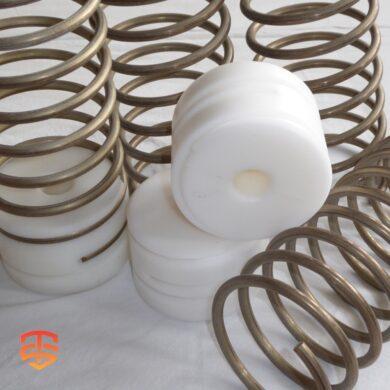 Spring Brake System | Primary & EAD zipline brake€ 80,00 Ex VAT
Spring Brake System | Primary & EAD zipline brake€ 80,00 Ex VAT

